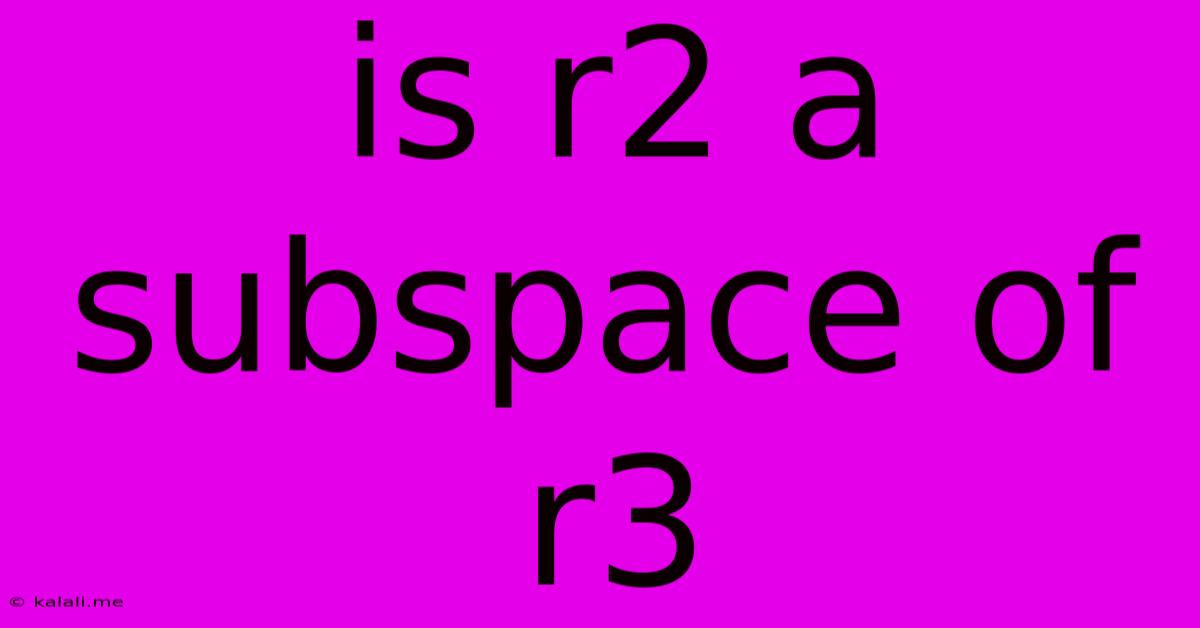Is R2 A Subspace Of R3
Kalali
May 23, 2025 · 3 min read

Table of Contents
Is R² a Subspace of R³? Understanding Vector Spaces and Subspaces
This article explores the question: is R² a subspace of R³? We'll delve into the definitions of vector spaces and subspaces, providing a clear and concise explanation, complete with examples. Understanding this concept is crucial for anyone studying linear algebra.
What are Vector Spaces and Subspaces?
Before we can determine if R² is a subspace of R³, we need to understand what these terms mean.
A vector space is a collection of objects called vectors, along with two operations, addition and scalar multiplication, that satisfy a set of axioms. These axioms ensure that the operations behave in a consistent and predictable manner. Familiar examples include R², R³, and Rⁿ (the set of all n-tuples of real numbers).
A subspace is a subset of a vector space that is itself a vector space under the same operations. To be a subspace, the subset must satisfy three conditions:
- The zero vector must be in the subset.
- The subset must be closed under addition. This means that if you add any two vectors in the subset, the result is also in the subset.
- The subset must be closed under scalar multiplication. This means that if you multiply any vector in the subset by a scalar (a real number), the result is also in the subset.
Analyzing R² and R³
Now let's analyze R² and R³. R² consists of all ordered pairs of real numbers (x, y), while R³ consists of all ordered triples of real numbers (x, y, z). We can visualize R² as a plane and R³ as three-dimensional space.
Why R² is NOT a subspace of R³
While R² and R³ share similarities—both are sets of vectors with addition and scalar multiplication defined—R² cannot be considered a subspace of R³. The key reason is the dimensionality mismatch.
- The Zero Vector: The zero vector in R³ is (0, 0, 0). While we can represent (0,0) as (0,0,0) by adding a third component, this doesn’t make R² a subspace of R³.
- Closure Under Addition and Scalar Multiplication: Even if we try to embed R² into R³ by adding a zero as the third component (e.g., representing (x, y) in R² as (x, y, 0) in R³), there’s a crucial point: while this representation satisfies the closure conditions, it doesn’t inherently mean R² is a subspace. Adding vectors (x1, y1, 0) and (x2, y2, 0) in R³ results in (x1+x2, y1+y2, 0), which still lies within our embedded representation of R². The same holds for scalar multiplication. However, this is just a cleverly chosen isomorphic representation, not inherent to R² itself. The crucial issue lies in the fact that the inherent structure of R² does not satisfy the conditions for being a subset of R³.
In essence, R² is not a subset of R³ in the way that fulfills the requirements of a subspace. It's a distinct vector space with a different dimension. To be a subspace, a subset must be contained entirely within the parent vector space. While we can find an isomorphic representation within R³, this doesn't equate to R² being a subspace.
Conclusion
Therefore, the answer is no, R² is not a subspace of R³. The difference in dimensionality prevents it from satisfying the necessary conditions for a subspace. Understanding this concept reinforces the importance of precisely defining vector spaces and subspaces in linear algebra.
Latest Posts
Latest Posts
-
How Many Grams Of Sugar In A Pound
Jul 12, 2025
-
7am To 11am Is How Many Hours
Jul 12, 2025
-
If Your 35 What Year Was You Born
Jul 12, 2025
-
How Many Cups Is 1 Pound Of Cheese
Jul 12, 2025
-
30 X 30 Is How Many Square Feet
Jul 12, 2025
Related Post
Thank you for visiting our website which covers about Is R2 A Subspace Of R3 . We hope the information provided has been useful to you. Feel free to contact us if you have any questions or need further assistance. See you next time and don't miss to bookmark.